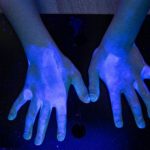 Radiation lying in the ultraviolet range: the wave lengths are shorter than light but longer than x-rays.
Radiation lying in the ultraviolet range: the wave lengths are shorter than light but longer than x-rays.
Light that has rays of shorter wavelength than visible light.
Invisible rays that occur naturally in sunlight. The ultraviolet light spectrum is divided into ultraviolet A (UVA), ultraviolet B (UVB), and ultra¬ violet C (UVC). UVA light is most responsible for the tanning and burning effects on the skin. Overexposure to ultraviolet light is associated with an increased risk of skin cancer, premature aging of the skin, suppression of the immune system, and cataracts.
Also known as cold light or actinic light; invisible light that has a short wavelength (giving it higher energy), is less penetrating than visible light, causes chemical reactions to happen more quickly than visible light, produces less heat than visible light, and kills germs.
A segment of the electromagnetic spectrum characterized by a wavelength slightly shorter than visible light is known to pose harm to living organisms, particularly to the eyes and DNA.
Ultraviolet light is a form of invisible light found just beyond the violet end of the visible light spectrum. It encompasses three categories based on wavelength: UVA for long wavelength, UVB for intermediate wavelength, and UVC for short wavelength.
Ultraviolet light is present in sunlight; however, a significant portion is absorbed by the ozone layer in the atmosphere. The ultraviolet light, primarily UVA, that manages to reach the Earth’s surface contributes to sun-induced tanning and the generation of vitamin D within the skin. Yet, it also carries potential risks, including the development of skin cancer.
Tanning beds utilize this type of light to induce suntanning. These beds are engineered to emit primarily UVA rays, although in reality, they also emit a minor quantity of UVB (which carries a higher risk of causing burns compared to UVA). Unfortunately, tanning beds can contribute to the development of skin cancer. Ultraviolet light is also generated by specific equipment like welding torches, carbon arcs, and lasers. When operating such equipment, it’s imperative to exercise precautionary measures, including wearing goggles at all times.
Ultraviolet light finds application in phototherapy for addressing specific skin ailments like psoriasis, eczema, and jaundice in newborns. An artificial source of ultraviolet light, the mercury-vapor lamp (also known as Wood’s light), can be utilized. This device aids in the artificial production of ultraviolet light. Moreover, it’s employed to diagnose skin conditions like tinea, as it induces fluorescence in the affected area.
